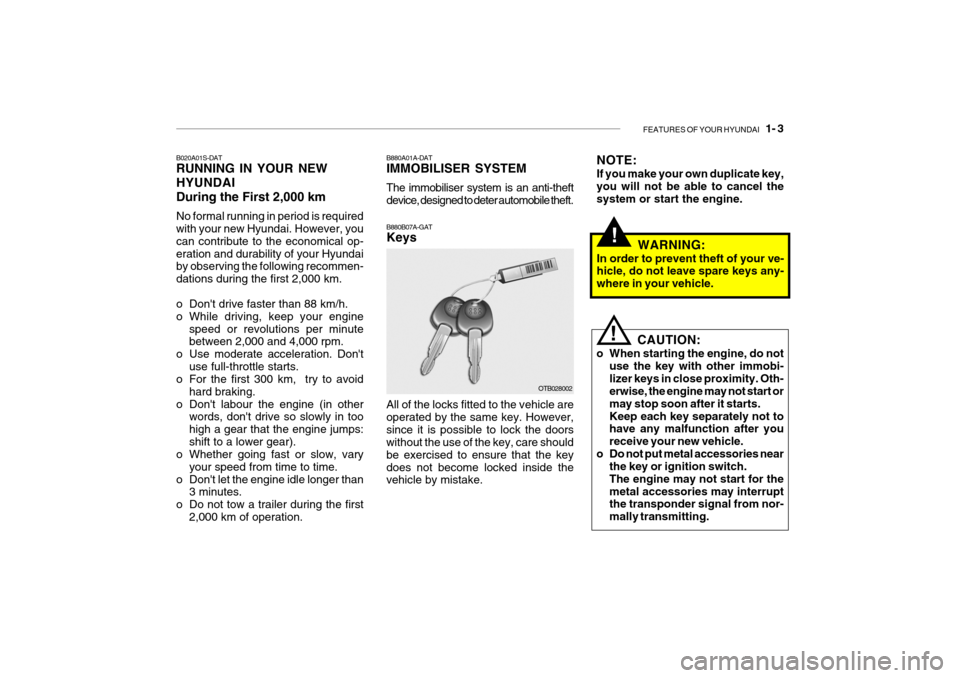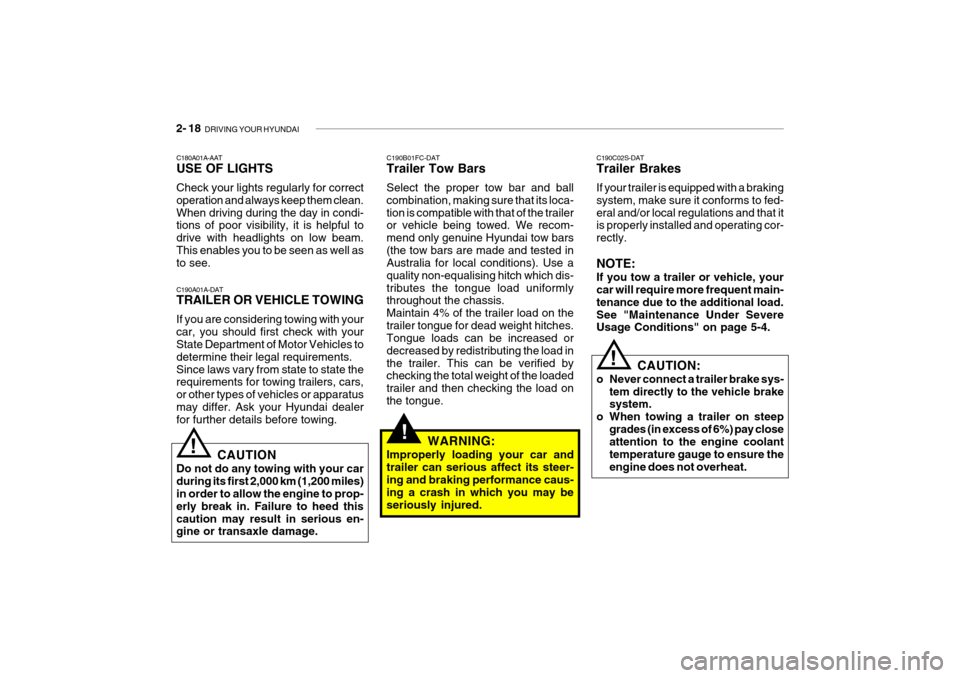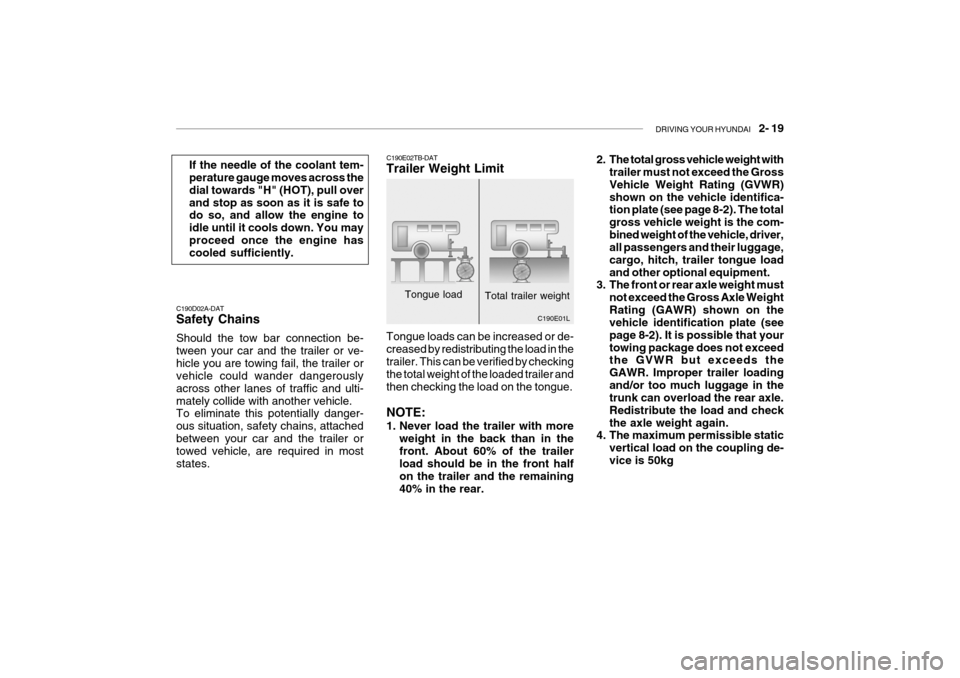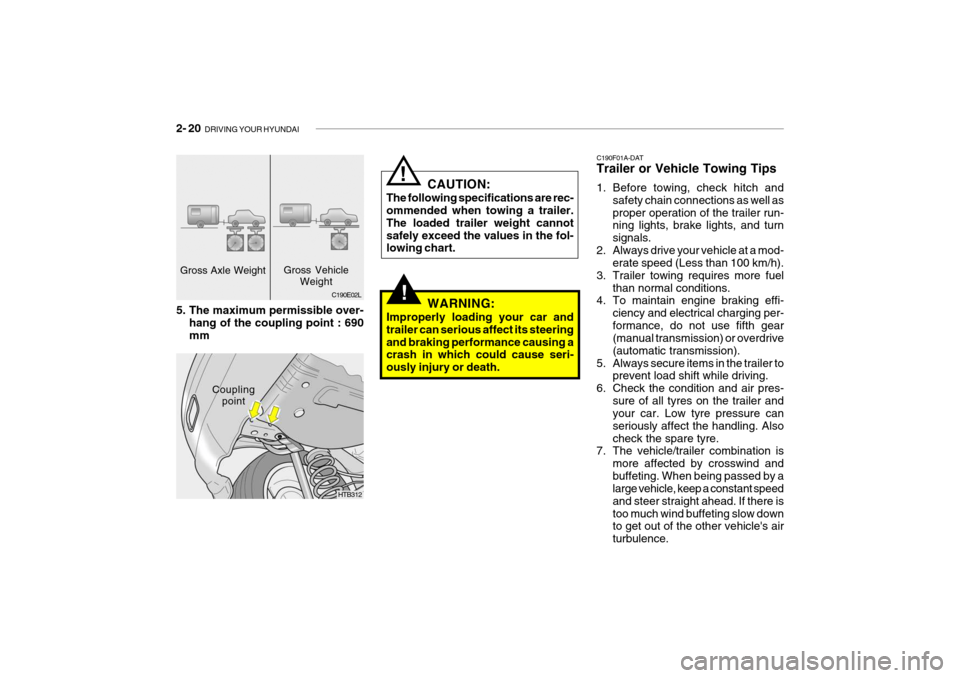trailer Hyundai Getz 2009 Owner's Manual - RHD (UK, Australia)
[x] Cancel search | Manufacturer: HYUNDAI, Model Year: 2009, Model line: Getz, Model: Hyundai Getz 2009Pages: 191, PDF Size: 6.3 MB
Page 14 of 191

FEATURES OF YOUR HYUNDAI 1- 3
B020A01S-DAT RUNNING IN YOUR NEW HYUNDAIDuring the First 2,000 km No formal running in period is required with your new Hyundai. However, you can contribute to the economical op-eration and durability of your Hyundai by observing the following recommen- dations during the first 2,000 km.
o Don't drive faster than 88 km/h.
o While driving, keep your engine
speed or revolutions per minute between 2,000 and 4,000 rpm.
o Use moderate acceleration. Don't use full-throttle starts.
o For the first 300 km, try to avoid
hard braking.
o Don't labour the engine (in other words, don't drive so slowly in too high a gear that the engine jumps:shift to a lower gear).
o Whether going fast or slow, vary
your speed from time to time.
o Don't let the engine idle longer than 3 minutes.
o Do not tow a trailer during the first 2,000 km of operation. B880A01A-DAT IMMOBILISER SYSTEM The immobiliser system is an anti-theft device, designed to deter automobile theft. B880B07A-GAT Keys
!
CAUTION:
o When starting the engine, do not use the key with other immobi- lizer keys in close proximity. Oth- erwise, the engine may not start or may stop soon after it starts.Keep each key separately not to have any malfunction after you receive your new vehicle.
o Do not put metal accessories near the key or ignition switch.The engine may not start for themetal accessories may interrupt the transponder signal from nor- mally transmitting.
OTB028002
All of the locks fitted to the vehicle are operated by the same key. However,since it is possible to lock the doors without the use of the key, care should be exercised to ensure that the keydoes not become locked inside the vehicle by mistake.
!WARNING:
In order to prevent theft of your ve- hicle, do not leave spare keys any- where in your vehicle.
NOTE: If you make your own duplicate key, you will not be able to cancel the system or start the engine.
Page 96 of 191

2. DRIVING YOUR HYUNDAI
Before starting the engine .............................................................. 2-3
Key position .................................................................................... 2-3Starting............................................................................................ 2-4
Operating the manual transaxle ..................................................... 2-5
Automatic transaxle ........................................................................ 2-7Good braking practices .................................................................. 2-11
Anti-Lock brake system (ABS) ...................................................... 2-12
Driving for economy ....................................................................... 2-13
Winter Driving ................................................................................. 2-14
Trailer or vehicle towing ............................. .................................... 2-18
2
Page 113 of 191

2- 18 DRIVING YOUR HYUNDAI
!
C190C02S-DAT Trailer Brakes If your trailer is equipped with a braking system, make sure it conforms to fed-eral and/or local regulations and that it is properly installed and operating cor- rectly. NOTE: If you tow a trailer or vehicle, your car will require more frequent main- tenance due to the additional load.See "Maintenance Under Severe Usage Conditions" on page 5-4.
!
C190B01FC-DAT Trailer Tow Bars Select the proper tow bar and ball combination, making sure that its loca-tion is compatible with that of the trailer or vehicle being towed. We recom- mend only genuine Hyundai tow bars(the tow bars are made and tested in Australia for local conditions). Use a quality non-equalising hitch which dis-tributes the tongue load uniformly throughout the chassis. Maintain 4% of the trailer load on thetrailer tongue for dead weight hitches. Tongue loads can be increased or decreased by redistributing the load inthe trailer. This can be verified by checking the total weight of the loaded trailer and then checking the load onthe tongue.
WARNING:
Improperly loading your car andtrailer can serious affect its steer-ing and braking performance caus- ing a crash in which you may be seriously injured. CAUTION:
o Never connect a trailer brake sys- tem directly to the vehicle brake system.
o When towing a trailer on steep grades (in excess of 6%) pay closeattention to the engine coolant temperature gauge to ensure theengine does not overheat.
C180A01A-AAT USE OF LIGHTS Check your lights regularly for correct operation and always keep them clean.When driving during the day in condi- tions of poor visibility, it is helpful to drive with headlights on low beam.This enables you to be seen as well as to see. C190A01A-DAT TRAILER OR VEHICLE TOWING If you are considering towing with your car, you should first check with your State Department of Motor Vehicles to determine their legal requirements.Since laws vary from state to state the requirements for towing trailers, cars, or other types of vehicles or apparatusmay differ. Ask your Hyundai dealer for further details before towing.
!
CAUTION
Do not do any towing with your car during its first 2,000 km (1,200 miles) in order to allow the engine to prop- erly break in. Failure to heed thiscaution may result in serious en- gine or transaxle damage.
Page 114 of 191

DRIVING YOUR HYUNDAI 2- 19
C190E02TB-DAT Trailer Weight Limit
Tongue load Total trailer weight
C190E01L
Tongue loads can be increased or de- creased by redistributing the load in the trailer. This can be verified by checking the total weight of the loaded trailer andthen checking the load on the tongue. NOTE:
1. Never load the trailer with more weight in the back than in the front. About 60% of the trailer load should be in the front half on the trailer and the remaining40% in the rear. 2. The total gross vehicle weight with
trailer must not exceed the GrossVehicle Weight Rating (GVWR)shown on the vehicle identifica- tion plate (see page 8-2). The total gross vehicle weight is the com-bined weight of the vehicle, driver, all passengers and their luggage, cargo, hitch, trailer tongue loadand other optional equipment.
3. The front or rear axle weight must
not exceed the Gross Axle WeightRating (GAWR) shown on the vehicle identification plate (see
page 8-2). It is possible that yourtowing package does not exceed the GVWR but exceeds the GAWR. Improper trailer loadingand/or too much luggage in the trunk can overload the rear axle. Redistribute the load and checkthe axle weight again.
4. The maximum permissible static
vertical load on the coupling de-vice is 50kgIf the needle of the coolant tem- perature gauge moves across the dial towards "H" (HOT), pull overand stop as soon as it is safe to do so, and allow the engine to idle until it cools down. You mayproceed once the engine has cooled sufficiently.
C190D02A-DAT Safety Chains Should the tow bar connection be- tween your car and the trailer or ve-hicle you are towing fail, the trailer or vehicle could wander dangerously across other lanes of traffic and ulti-mately collide with another vehicle. To eliminate this potentially danger- ous situation, safety chains, attachedbetween your car and the trailer or towed vehicle, are required in most states.
Page 115 of 191

2- 20 DRIVING YOUR HYUNDAI
!
C190F01A-DAT Trailer or Vehicle Towing Tips
1. Before towing, check hitch and
safety chain connections as well as proper operation of the trailer run- ning lights, brake lights, and turn signals.
2. Always drive your vehicle at a mod- erate speed (Less than 100 km/h).
3. Trailer towing requires more fuel than normal conditions.
4. To maintain engine braking effi-
ciency and electrical charging per-formance, do not use fifth gear (manual transmission) or overdrive (automatic transmission).
5. Always secure items in the trailer to prevent load shift while driving.
6. Check the condition and air pres- sure of all tyres on the trailer and your car. Low tyre pressure can seriously affect the handling. Alsocheck the spare tyre.
7. The vehicle/trailer combination is
more affected by crosswind andbuffeting. When being passed by a large vehicle, keep a constant speed and steer straight ahead. If there istoo much wind buffeting slow down to get out of the other vehicle's air turbulence.
!
Gross Axle Weight
Couplingpoint C190E02L
Gross Vehicle
Weight
HTB312
5. The maximum permissible over-
hang of the coupling point : 690 mm CAUTION:
The following specifications are rec- ommended when towing a trailer. The loaded trailer weight cannotsafely exceed the values in the fol- lowing chart.
WARNING:
Improperly loading your car and trailer can serious affect its steeringand braking performance causing a crash in which could cause seri- ously injury or death.
Page 116 of 191

DRIVING YOUR HYUNDAI 2- 21
14. When going down a hill, shift into a
lower gear and use the engine brak- ing effect. When ascending a longgrade, downshift the transmission to a lower gear and reduce speed to reduce chances of engine over-loading and/or overheating.
15.If you have to stop while going
uphill, do not hold the vehicle inplace by pressing on the accelera- tor. This can cause the automatic transmission to overheat. Use thehand brake or footbrake.
NOTE: When towing, check transaxle fluid more frequently. 1. Turn off the air conditioner.
2. Reduce highway speed.
3. Select a lower gear when going up-
hill.
4. While in stop and go traffic, place
the gear selection in park or neutraland idle the engine at a higher speed.
CAUTION:
If overheating should occur whentowing, (temperature gauge reads near red zone), taking the following action may reduce or eliminate theproblem.
!
8. When parking your car and trailer,
especially on a hill, be sure to follow all the normal precautions. Turnyour front wheel into the curb, set the hand brake firmly, and put the transmission in 1st or Reverse(manual) or Park (automatic). In addition, place wheel chocks at each of the trailer's tyres.
9. If the trailer has electric brakes, drive your vehicle with the trailerattached, and then apply the trailerbrakes by hand. This test confirms the operation of the trailer brakes and also checks your electrical con-nection at the same time.
10.During your trip, check occasion-
ally to be sure that the load issecure, and that the lights and any trailer brakes are still working.
11.Avoid jerky starts, sudden accel- eration or sudden stops.
12.Avoid sharp turns and rapid lane
changes.
13.Avoid holding the brake pedal down too long or too frequently. This could cause the brakes to overheat, re-sulting in reduced braking efficiency. D120A02A-DAT IF YOU LOSE YOUR KEYS If you happen to lose your leys, your vehicle will require towing to your Hyundai dealer to have the new set ofkeys programmed to your vehicle.
Page 139 of 191

5- 6 VEHICLE MAINTENANCE REQUIREMENTS
SEVERE DRIVING CONDITIONS
A - Repeatly driving short distance of less than 8km in normal
temperature or less than 16km in freezing temperature
B - Extensive engine idling or low speed driving for long dis- tances
C - Driving on rough, dusty, muddy, unpaved, graveled or salt- spread roads
D - Driving in areas using salt or other corrosive materials or in
very cold weather R R RR
I I I I
R RR
ENGINE OIL AND FILTER AIR CLEANER FILTER SPARK PLUGSTIMING BELT BRAKE PADS, CALIPERS AND ROTORS REAR BRAKE DRUMS/LININGS/PADS,PARKING BRAKE STEERING GEAR BOX, LINKAGE & BOOTS/LOWER ARM BALL JOINTDRIVESHAFTS AND BOOTS MANUAL TRANSAXLE OIL AUTOMATIC TRANSAXLE FLUID
AIR CONDITIONER FILTER (For Evaporator and Blower unit)
F040A01TB-DAT
MAINTENANCE UNDER SEVERE USAGE CONDITIONS
The following items must be serviced more frequently on cars normally used under severe driving conditions. Refer tothe chart below for the appropriate maintenance intervals. R : Replace I : Inspect and, after inspection, clean, adjust, repair or replace if necessary
MAINTENANCE ITEM
EVERY 7,500 KM OR 6 MONTHS MORE FREQUENTLY MORE FREQUENTLYEVERY 60,000 KM OR 48 MONTHS MORE FREQUENTLY MORE FREQUENTLY MORE FREQUENTLY EVERY 15,000 KM OR 12 MONTHS EVERY 100,000 KM EVERY 40,000 KMMORE FREQUENTLY A, B, C, D, E, F, G, H, I, K C, E B, HD, E, F, G, I C, D, G, H C, D, G, H C, D, E, F C, D, E, F C, D, E, G, H, I, J A, C, E, F, G, H, IC, E
MAINTENANCE
INTERVALS DRIVING
CONDITION
MAINTENANCE
OPERATION
E - Driving in sandy areas
F - Driving in heavy traffic area over 32°C
G - Driving on uphill, downhill, or mountain road
H - Towing a Trailer, or using a camper, or roof rack
I - Driving as a patrol car, taxi, other commercial use
or vehicle towing
J - Driving over 170 Km/h
K - Frequently driving in stop-and-go conditions
Page 191 of 191

INDEX 10- 5
S Seat
Front ........................................................................ 1-12
Seatback Holder ......................................................... 1-65
Seat Belts
3-Point system ........................................................ 1-20
Adjustabl e height ..................................................... 1-19
Adjusting your seat belt ........................................... 1-21
Maintenance of seat belts ....................................... 1-19
Seat pocket ................................................................ 1-66
Spectacle Ca se .......................................................... 1-58
Speedometer .............................................................. 1-42
Starting ........................................................................ 2-4
Steering Wheel Freeplay ............................................. 6-16
Steering Wheel Tilt Lever ........................................... 1-69
Stereo Sound System ................................................ 1-80
Sun Visor .................................................................... 1-68
Sunroof ....................................................................... 1-54
TTachometer ................................................................. 1-42
Tail gate ..................................................................... 1-65
Theft-Alarm system ..................................................... 1-7
Towing A trailer (or vehicle) ................................................. 2-18
Emergency .............................................................. 3-10
If your car must be towed ........................................ 3-8 Transaxle
Automatic ................................................................. 2-7
Automatic transaxle fluid checking .......................... 6-11
Manual ...................................................................... 2-5
Manual transaxle Oil checking ................................ 6-10
Trip Computer ............................................................. 1-43
Trip Odometer ............................................................. 1-42
Tyres Balancing .................................................................. 8-5
Chains ...................................................................... 8-4
Information ............................................................... 8-3
Pressure ................................................................... 8-3
Rotation .................................................................... 8-4
Snow tyres ............................................................... 8-4
Spare tyre ................................................................. 3-5 Traction ..................................................................... 8-5
Wheel and tyre changing .......................................... 3-5
V Vehicle Identification Number ..................................... 8-2
WWarning Lights ............................................................ 1-37
Windshield Wiper and Washer ....................................1-48
Windshield Wiper Blades ............................................. 6-8